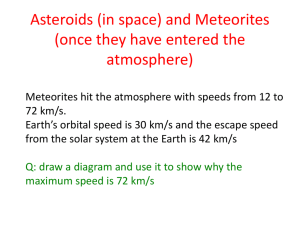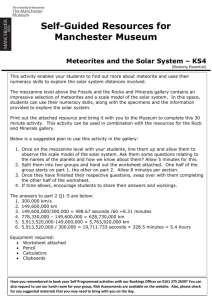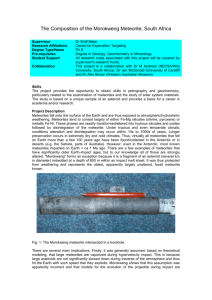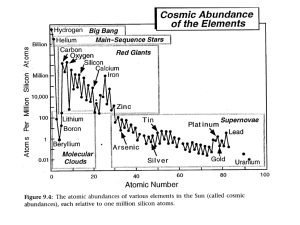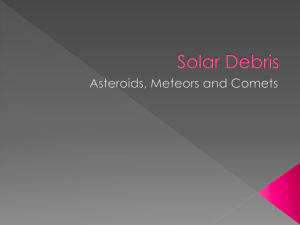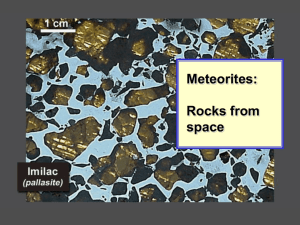Solar System Debris and its Effects on Earth
advertisement
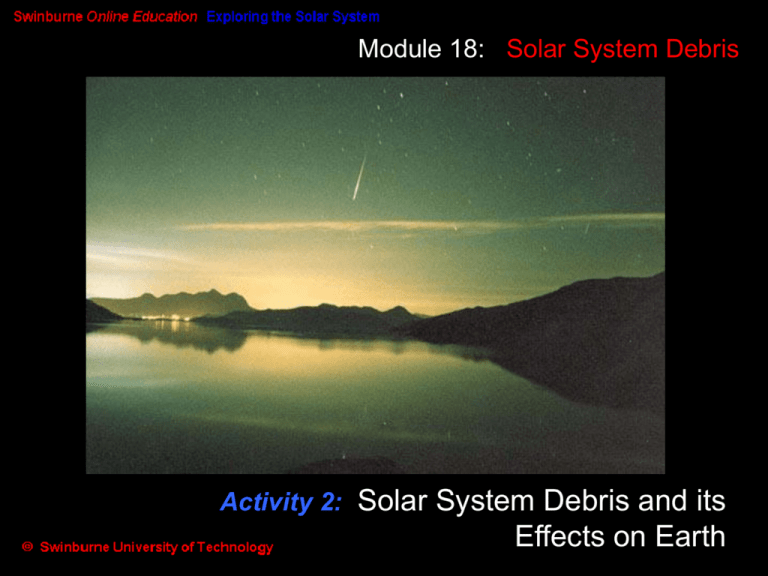
Module 18: Solar System Debris Activity 2: Solar System Debris and its Effects on Earth Summary: In this Activity we will investigate (a) dust and the solar wind; (b) meteoroids, meteors & meteor showers; (c) meteorites - composition and possible origin; (d) lunar and martian meteorites; (e) meteorite craters, explosions, and global extinctions; and (f) tracking space debris, risks of major Earth impacts, and taking evasive action? (a) Dust and the Solar Wind As we saw in the Activity Comets, comets’ dust tails always point away from the Sun. This lead Kepler to suggest in the early 1600s that cometary tails were effected by the pressure of sunlight. Ion tail The ion tails of comets, however, point in a slightly different direction (though still away from the Sun). In 1951 Ludwig Biermann studied Dust tail the deviation between the ion and dust tails of comets and suggested that a “solar corpuscular radiation” must be sweeping away the ions at high speeds. He predicted that the Sun released a steady stream of charged particles with speeds of a few 100 km/s. The solar wind, a stream of ionised gas emanating from the Sun, was discovered ten years later in 1962. At the location of the Earth (1 AU from the Sun) the solar wind flows at a speed of 450 km/s and “sweeps” dust particles along its path. The solar wind is not steady, however, but varies in both time and space. The solar wind will be examined in detail in the Module Solar Activity and its Effects on Earth. (b) Meteors & Meteor Showers A meteoroid is a piece of rocky space debris orbiting the Sun at typically 20 - 40 km/s, some of which are on a collision course with the Earth. meteoroid A meteor is the fireball seen in the sky when a meteoroid collides with the Earth’s atmosphere. A meteorite is the remnant of a meteoroid which has survived the fireball to impact on the Earth’s surface. If you stare up at the night sky for more than a few minutes, you’ll probably see a “shooting star”, which is not actually stars at all, but a meteor, which is a light phenomenon that occurs when meteoroids burn up as they enter the Earth’s atmosphere. Meteors are seen when meteoroids larger than a few millimetres in size collide with the atmosphere at speeds greater than ~10 km/s. As they stream through the Earth’s upper atmosphere, the friction heats the grain, and atoms on the outer surface are ablated. These ablated atoms continue to collide with atmospheric atoms, which become excited and ionized. A train several kilometres long of ionised and glowing atmospheric gas is seen in the sky as a “shooting star” or meteor. The brightness and the length of meteors depends on how fast the meteoroid is travelling and the angle at which it strikes the upper atmosphere. So where do meteoroids come from? Some are leftover bits of junk from the formation of the Solar System, others are bits of rock that are ejected into space during collisions between asteroids and meteorites, and others still are grains from evaporated comets. As comets burn out*, dust and rock fragments form a compact meteoric swarm which for many years continues to circle the Sun in the Orbit of orbit of the parent comet. meteoroid swarm When the Earth’s orbit crosses the path of a meteoritic storm of an existing or burnt out comet, we experience a meteor shower, when Sun hundreds or even thousands of meteors per hour can be seen. Earth * refer to Activity Comets and the Dirty Snowball Model Meteor showers are more intense when the comet’s nucleus has recently passed near the point where the two orbits cross. The Leonids meteors are dust particles from the Temple-Tuttle comet, which orbits the Sun every 33 years. The Earth’s orbit carries it through the Temple-Tuttle meteoritic swarm on November 17and 18 each year. The highest concentration of meteoroids is found just behind the comet itself, so when comet Temple-Tuttle passes closest to the Sun - which it last did in 1998 - the dust supply of the Leonids is replenished, giving rise to stronger than usual meteor showers. Leonid meteor shower (c) Rocks that Fall from the Sky... If a chunk of rock from space survives the fiery passage through the Earth’s atmosphere and actually lands on the surface, we call it a meteorite. To survive the passage through the atmosphere, the rock must be quite large to begin with. Meteorite falls at any one location on the earth are rare, but over the entire Earth, hundreds of meteorites fall each year. The extraterrestrial nature of meteorites was not widely believed until the late 1700s, when German physicist Ernst Chladni suggested that the strange looking rocks fell from the sky. This was confirmed in 1803 by French physicist Jean Baptiste Biot, who studied freshly fallen meteorites from a well observed fall. Most meteorites are picked up off the ground in finds rather than actually observed in falls . There are 3 main classes of meteorites: the irons, the stones, and the stony-irons. As their names imply, meteorites are classified by their composition. The irons are composed of nearly pure metallic iron-nickel; the stones are made of rocky mostly silicate material; and the much rarer stony-irons are a mix of stone and iron. The irons and stony-irons are more obviously extraterrestrial, as ‘pure’ iron is very rare on Earth (it is usually found in oxides). The stones are the more common type, but are difficult to recognise as they look much like terrestrial rocks. Meteorite Composition The iron meteorites are composed of about 90% iron and 10% nickel. They make up about 4% of the Earth’s meteorites. The stony-irons are composed of about 50% silicates and 50% iron, and make up only about 1% the of meteorite falls. Iron meteorite The stones make up the remaining 95% of meteorite falls, and are divided into three types: chondrites, achondrites & carbonaceous. (1) chondrites are composed of silicate rock & rounded bits of glassy rock called chondrules. They are the most common form of stony Chondrite meteorite. (2) achondrites are stony meteorites which do not contain chondrules or volatiles Achondrite and have far less iron than chondrites. (3) carbonaceous meteorites, as their name suggests, contain carbon and some complex organic material. They can also contain as much as 20% water and other volatile compounds. Meteorite Origins The real significance of meteorites was not fully appreciated until their ages were determined, the oldest being dated at 4.6 billion years old! This means that meteorites not only sample planetary bodies (mostly asteroids) that we otherwise couldn’t study, but they also give us an insight into the early Solar System and its formation. A more fundamental classification scheme for meteorites than their composition is the distinction between the differentiated and primitive meteorites, as this tells of their thermal history. Some meteorites - including all of the iron, all the stony-irons and some of the stones - have clearly experienced a lot of heating in their past and are derived from broken up differentiated bodies that have been chemically sorted. This means that the parent bodies have been heated to a molten state, allowing the more dense material to fall to their centre and the less dense material to float to their surface. The irons would have come from the cores of these bodies, which were most probably asteroids, while the stony-irons come from the region between the core and stony mantle. The primitives, on the other hand, have not experienced high temperatures or pressures and are thought to record the earliest history of the Solar System. They are believed to have condensed directly out of the solar nebula, making them the most ‘pristine’ material in the Solar System. Most of the meteorites found on Earth are primitive stones, including the chondrites and carbonaeous stones - both of which contain volatiles, which indicate little or no heating. (The achondrites, on the other hand, have clearly been heated and are in the differentiated group.) The following relationship between meteorites and asteroids, while not strictly true, can be used as a guide: Meteorites Irons Stony-Irons Stones* Asteroids M class S class C class * carbonaceous stones Meteorites and the Early Solar System To learn more about the conditions in the early Solar System, we need to look more closely at the primitive meteorites, which contain a complex but primitive mixture of pre-planetary material. In fact, some primitive meteorites actually contain traces of interstellar gas that has survived the planet formation process! Chondrules are small spherical pebbles, generally 0.1 mm to 10 mm in size, found in the primitive chondrites. They are thought to have solidified from melted droplets directly out of the solar nebula, making them some of the oldest solid material in the Solar System. 0.1mm Chondrules formed in very rapid heating events (maybe via a shock front or lightning discharge), and the glassy nature of many chondrules also indicates that they cooled extremely rapidly. Their exact formation mechanism is still strongly debated. (d) Lunar and Martian Meteorites While most meteorites are thought to have derived from asteroids, there are a small number that have been identified as originating from Mars and the Moon. When a large piece of space debris (such as an asteroid) impacts with a planetary body and forms impact craters 100km in size or more, some of the surface rock can be ejected with enough speed to escape the gravity of the planet. The ejected material may later* collide with the Earth. clongg! *sometimes millions of years later! Lunar meteorites How do we know that lunar meteorites are actually from the Moon? The composition and isotope ratios of these meteorites have been compared with the samples brought back from the Moon during the Apollo mission. Lunar meteorites are extremely rare - less that 0.1% of all meteorites are of lunar origin. There have been about 60 lunar meteorites found on Earth, some of these are “paired” (meaning they fell to Earth in a group). Overall they represent just over 20 impact sites on the Moon. The lunar meteorites help us understand the geological history of the Moon in greater detail. For more information, visit the Lunar Meteorites website at: http://epsc.wustl.edu/admin/resources/moon_meteorites.html Martian Meteorites There are also 30 meteorites that are know to originate from Mars. We know these meteorites are Martian from trace amounts of gas that resembles the atmosphere of Mars, which is trapped within microscopic pockets of the rocks. The most interesting (or at least the most famous!) of the Martian meteorites is ALH84001. This Martian rock (which is 4.5 billion years old) was ejected from Mars 16 million years ago, landed in the Allen Hill Ice Field of Antarctica 13,000 years ago, and was finally picked up in 1984. ALH84001 made world headlines in 1996 when it was found to contain evidence for ancient life on Mars... ALH84001 contains tiny traces of organic compounds called Polycyclic Aromatic Hydrocarbons (PAHs), which can be produced by decaying organisms!* These tubular structures in ALH84001, found clinging to carbonate grains, resembles terrestrial bacteria. Whether or not this is really evidence of ancient life of Mars is still unclear... Magnified 100,000 times. Note the tubular structure which may be fossils of microorganisms. For details of the Martian meteorites, visit: http://www.jpl.nasa.gov/snc/ * but also produced chemically and commonly found in space (e) Meteorite Craters, Explosions and Mass Extinctions Meteoroids (and asteroids) generally travel with velocities in the range of 10 to 70 km/s, which means that they have considerable kinetic energy. Upon impact, the kinetic energy is transferred to the surface of the target body and the meteoroid will generally dig 2 or 3 times its diameter into the surface. What results is an impact crater. The exact dimensions of the crater also depend on the target body. The resulting crater diameter is The more massive the target body, usually several times its depth. the faster the meteoroid will be pulled towards it. An atmosphere can help slow down the impacter. Craters The diameter of craters formed when large meteorites strike the Earth are typically 10-20 times as large as the diameter of the meteorite which causes it. Wolf Creek Crater, Western Australia Using this rule of thumb, the meteoroid which created the Barringer Crater would have had a diameter between 50 and 100 meters. About 1000m 200m Barringer Meteor Crater, Arizona USA The Tunguska Explosion Not all meteoroids make it to the Earth’s surface. Obviously small meteoroids burn up in the Earth’s atmosphere, but some larger meteoroids can actually explode in the air before they hit the ground. Such an event is often called a fireball. One example was when a stony asteroid struck the Earth’s atmosphere above the Tunguska region of Siberia in 1908. When it exploded before reaching the surface, the mass of about 100 megatonnes released the energy equivalent to a nuclear detonation of several hundred kilotons. The Tunguska explosion was felt hundreds of kilometers away and felled trees over an area of 2000 square kilometers. Obviously the effects of an impact can be devastating. A large meteorite impacting with the Earth would vaporise itself as well as a large volume of terrestrial rock. Solid and molten rock would be sprayed several thousand kilometres. As well as localised effects, giant impacts can lead to prolonged darkness due to dust particles obscuring the Sun. Intense acid rain and heating of the atmosphere are also possible consequences of such an event. If we look at the cratering rate with time, we can see that there are far less impacts now than in the past (which is good for us!). impacts per year time It is thought that an asteroid 1 km in diameter hits the Earth once every 100,000 years or so, and an asteroid 5 km in diameter once every 5 million years... However, recent simulations from scientists at the Imperial College London and the Russian Academy of Sciences have found that more asteroids are destroyed upon entry into the Earth’s atmosphere than previously estimated. The study found that asteroids with diameters greater than 200 metres will hit the Earth’s surface every ~160,000 years – compared to previous estimates of impacts every ~2,500 years. Mass Extinctions One of the best studied large Earth impacts occurred 65 million years ago , which separates the Cretaceous and Tertiary geologic periods. This boundary, the K-T boundary, coincides with a mass extinction that wiped out over half the species on Earth. There are about a dozen mass extinctions in geological history, but the KT boundary gets a lot of attention because it wiped out the dinosaurs. A worldwide layer of sediment rich in iridium (a mineral rare on Earth but common in meteoroids) at the KT boundary, from New Zealand to Denmark, was discovered in 1980. It was suggested that the entire Earth was enshrouded in a dust cloud from a giant impact, which sent dust and ash into the atmosphere, turning day to night and lowering the average temperature. This dark winter probably lasted several years. Plants and then animals died leading to a mass extinction. The search for the giant impact crater began, and finally in 1990 the Chicxulub crater was found off Mexico’s Yucatan Peninsula. The crater is buried under several kilometres of sediment, but geologic mapping allows us to reconstruct the crater, which is about 180km in diameter - making it the largest impact crater on Earth. The impacting body must have been about 20km in size. The impact itself would have created a massive earthquake, a 100 m tidal wave that raced across the Gulf of Mexico, and lifted about 100 trillion tons of dust into the atmosphere! (f) Tracking Space Debris The potential for Solar System debris to cause global catastrophe makes it crucial to trace the trajectories of objects whose paths will take them near the Earth. To determine the orbit of a Near Earth Object you need as many precise measurements of its position in the sky as possible. The time spread of these observations is important; better to have 10 positions over 3 months than 50 positions over one week. This means it is advantageous to have teams working on detection in both hemispheres. This plot shows the location of the 4 terrestrial planets and the minor planets of the inner Solar System. The green objects reside in the asteroid belt, while the red objects have their closest approach to the Sun within 1.3AU, and are thus considered Near Earth Objects. It is estimated that there are about 1000 NEOs with diameters over 1 km, including over 550 “potentially hazardous” asteroids. Inner Solar System, 7 February 2003 from the Minor Planet Centre For more information about NEO tracking, visit: NASA’s Near Earth Asteroid Tracking http://neat.jpl.nasa.gov/ NASA’s Near Earth Object Program http://neo.jpl.nasa.gov/ In this Activity, we have examined the nature of various types of Solar System debris, from meteors to meteorites, and their effect on the Earth. In the next Activities we will move to the centre of the Solar System and examine the Sun; its structure, energy and fuel, and its effects on the Earth. Image Credits Leonid meteor shower © Yan On Sheung http://www.leonidslive.com/images/hkdawn_big.jpg 1966 Leonids meteor show, Scott Murrell http://science.nasa.gov/newhome/headlines/ast10nov98_1.htm The Earth, NASA http://antwrp.gsfc.nasa.gov/apod/ap971026.html Lunar craters: Images from Apollo 11 mission http://www.nasm.edu/APOLLO/AS11/AS11-44-6611.t.gif ALH84001 http://wwwcurator.jsc.nasa.gov/curator/antmet/marsmets/life.htm Comet Hale Bopp, © Michael Brown Uni. Of Melb., used with permission http://www.ph.unimelb.edu.au/~mbrown/astrogif/hale-bopp.html Barringer Meteor Crater http://antwrp.gsfc.nasa.gov/apod/ap971117.html Wolf Creek meteorite crater, Camboon Primary School http://iinet.net.au/~ramen/graphics/wolf.jpg Image Credits Meteorite chondrule, © Sasha Krot http://www.higp.hawaii.edu/~sasha/caichd.html Chicxulub crater, V.L.Sharpton, Lunar & Planetary Institute http://antwrp.gsfc.nasa.gov/apod/ap000226.html NEOs of the inner Solar System - Minor Planets Centre (used with kind permission) http://cfa-www.harvard.edu/iau/lists/InnerPlot2.html Now return to the Module 18 home page, and read more about Solar System debris in the Textbook Readings. Hit the Esc key (escape) to return to the Module 18 Home Page

